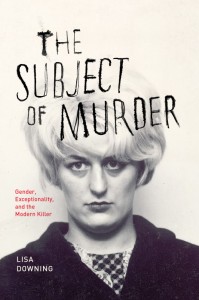 My book, The Subject of Murder: Gender, Exceptionality, and the Modern Killer, which took me six years to write, and which has been in production for over 12 months with Chicago University Press, is finally available for pre-order, though it won’t be in the world until next year. It is a relative snip at $25 / £15.
My book, The Subject of Murder: Gender, Exceptionality, and the Modern Killer, which took me six years to write, and which has been in production for over 12 months with Chicago University Press, is finally available for pre-order, though it won’t be in the world until next year. It is a relative snip at $25 / £15.
You can pre-order it here and see the table of contents here.
This is Chicago University Press’s catalogue copy describing the book:
“The subject of murder has always held a particular fascination for us. But, since at least the nineteenth century, we have seen the murderer as different from the ordinary citizen—a special individual, like an artist or a genius, who exists apart from the moral majority, a sovereign self who obeys only the destructive urge, sometimes even commanding cult followings. In contemporary culture, we continue to believe that there is something different and exceptional about killers, but is the murderer such a distinctive type? Are murderers degenerate beasts or supermen as they have been depicted on the page and the screen? Or are they something else entirely?
In The Subject of Murder, Lisa Downing explores the ways in which the figure of the murderer has been made to signify a specific kind of social subject in Western modernity. Drawing on the work of Foucault in her studies of the lives, crimes, and legends of killers in Europe, Britain, and the United States, Downing interrogates the meanings of media, medical, legal and creative texts produced about and by murderers. Upending the usual treatment of murderers as isolated figures or exceptional individuals, Downing instead argues that murderers are ordinary people, reflections and symptoms of our society at the intersections of gender, agency, desire, and violence.”
I’ll hope to post more here on the sex-critical aspects of the book, which perhaps don’t appear obvious in the Press’s copy, in the run-up to publication. The book interrogates, in particular, how the perceived gender, sexuality, class, ethnicity and age of given killers determine the treatment they receive and the ways they are represented in the discourses produced about them. The more they deviate from the white, male, heterosexual default social subject (who is also the default “subject of murder”, since murder is a product of, not other to, society), the more aberrant they are made to appear.